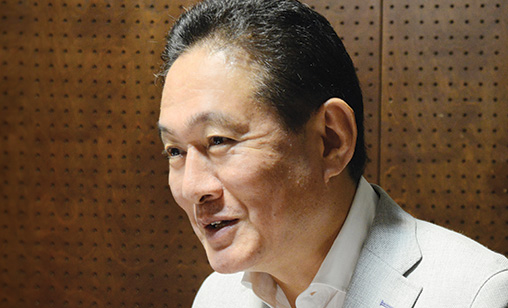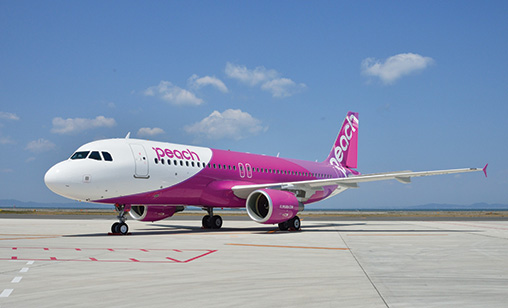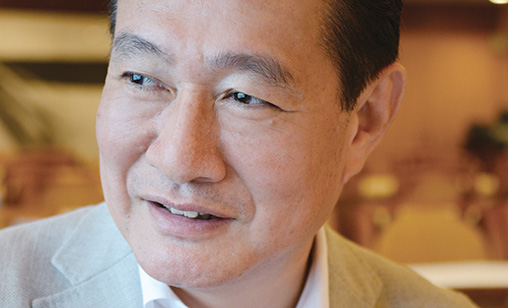Cover Story
Natural born airline leader
Shinichi Inoue, the extroverted boss of Peach Aviation, the first “made in Japan” low-cost carrier, has built the airline’s success on brutal pricing discipline and person-to-person marketing intelligence.
September 1st 2016
Joint venture budget carrier CEO, Peach Aviation Ltd’s Shinichi Inoue is a very different kind of Japanese boss. Read More » Fluent in English and Mandarin and never too busy to stop and chat with his staff, he is a tieless and tireless leader of a new type of Japanese airline: a successful low-cost carrier.
Good humoured as well as approachable, Inoue takes inspiration and ideas from his workers – from ground staff to the cabin and the cockpit – as well as his manager lieutenants – when setting strategy at Peach.
 |
It is this approach of believing that employee feedback builds an accurate picture of customer reactions, demands and trends that has been a significant factor in Peach’s success and also that of Inoue’s squire ship of the carrier.
He is also acknowledged by colleagues as “having a bit of the show man” about him with an eye for good publicity. When Peach was launched in early 2012, he donned a captain’s uniform and posed with flight attendants for the occasion, a rare example indeed of a Japanese CEO lightening up for the cameras.
Inoue was All Nippon Airways’ (ANA) director of corporate affairs Asia before he moved to Peach Aviation Ltd to work on its formative strategy in 2011. He was a clear favourite to head the team that set up Peach and was appointed its CEO and Representative Director, and later its president when the budget carrier was formally established.
Despite some industry scepticism about the Japanese appetite for budget flying, Peach Aviation became the first Kansai based “Asian regional” airline with an original business model. Based at Kansai International Airport in Osaka, it was set up as an unconsolidated subsidiary of ANA Holdings and is run as a financially independent entity.
As Japan’s first LCC, Peach was launched in March 2012 with domestic services from Osaka to Sapporo and Fukuoka. International flights commenced two months later to Seoul, South Korea. At year-end 2012, the airline had added Hong Kong and Taipei (Taoyan) to its groundbreaking operations.
In November of its inaugural year, Peach had carried more than one million passengers and was the first Japanese LCC to hit the magic million mark for seats sold. It also became the first home-grown LCC to make an operating profit, achieved in its second year of business, to March 31, 2014.
Peach followed up that success with two consecutive years of increased revenue and profits, which has allowed the airline to pay off its accumulated losses and to start the current year, ending March 31, 2017, with a clean financial slate.
In the 12 months ended this March 31, Peach reported operating revenue of 47.939 million yen (US$475,620) and earned an operating profit of 6.181 million yen. Net earnings were 2.744 million yen. Average seat load factor was 86.7% and the number of revenue passengers was 4.55 million.
| Bred for success Shinichi Inoue, the Representative Director and CEO of Peach Aviation Limited, was born and raised in the Shonan district of Kanagawa Prefecture, a region adjacent to Tokyo and bordering the Pacific Ocean to the south. Inoue (58) graduated in law from the prestigious and internationally successful private Waseda University in l982. The highly regarded tertiary institution has produced seven prime ministers and scores of leaders of industry, including the maverick founder of Sony. From 1982 until 1990, Inoue worked for Mitsubishi Heavy Industries in thermal power plant development. He moved to All Nippon Airways in 1990 and until 2011 held senior management positions at the airline, both in Japan and overseas, before he took on Peach Aviation. Married with three sons, he has maintained his family home in Shonan, where he enjoys reading for relaxation, particularly non-fiction history. Last November, Japanese Prime Minister, Shinzo Abe, established a panel that is developing a program aimed at increasing overseas visitors to Japan to 40 million by 2020. Chaired by Abe, it includes 10 cabinet ministers and seven outside expert advisers, including Inoue, the only airline industry representative on the panel. |
In the current year, Peach is forecast to carry between five and six million passengers, increasing to six to seven million in the following year.
These estimates could be on the low side as inbound traffic continues to record strong growth. Inoue said Peach passengers could reach 10 million for the 2018 year.
According to the Japan National Tourist Organization (JNTO), visitors to Japan in the January-June period this year grew 28.2 % over the same months a year ago, to a record 11,713,800. The figures topped the 10-million threshold for the first time for a first half performance.
It was the fifth consecutive year that first half visitor numbers had increased, said JNTO, with the growth led by more international flights and cruise ship visits.
The original target for foreign visitors was 20 million by 2020, the year of the Tokyo Olympics, but that target was reached last December. By 2020, inbound visitors to the country could increase to 30 million, said Japan’s tourism officials.
Clearly, Peach has shown that the LCC business model can succeed in Japan, despite the country’s unique commercial aviation environment.
 |
But in 2012, sceptics predicted Japanese LCCs would fail because of the country’s stringent regulations and Japanese travelers’ demands for highly personalized service.
At Peach, Inoue attributes four factors critical to the LCC’s strong performance: operational quality, cost management, branding and innovation.
“Since we started we have tried hard to explain to customers that they should see us as a ‘flying train’ so people would perceive aircraft as an everyday mode of transport,” said Inoue.
“With our range of low fares this ‘train’ concept has been well-accepted and more and more people are enjoying low-cost travel. We are changing people’s lifestyles – and making air travel a normal everyday event.”
Led by Peach, the low fares created by Japanese LCCs have attracted customers who had never flown. Women, retirees, students and, increasingly, business travelers, are all marketing targets for the carrier.
Travelers who had used express buses or sea ferries can now fly on an LCC for the same price, but the journeys are much shorter. Retirees who have the time to travel now do so more frequently thanks to the low fares offered by LCCs. To cater particularly for this market, Peach has developed its “Active 60” fare campaign.
Another promising market is staff at Japanese banks and trading companies as well as members of the civil service who are regularly posted to provincial offices, usually without their families. LCCs help these families stay in touch at weekends and holidays.
Female office workers, especially young working women with limited vacation time, can book LCC packages such as one-day shopping or gourmet dining trips from Osaka to Seoul, South Korea. Female travelers from Taipei fly to Okinawa for beauty treatments.
The airline is paying special attention to young female travelers interested in style and casual luxury. The Peach livery, for example, attracts many “selfie” photo takers among female flyers of all nationalities.
Before it launched, Peach asked local residents in the Kansai region what they would like to experience as an airline passenger.
| Cardboard creativity Outstanding among the innovations that Peach has introduced into the industry are self-service check-in kiosks made largely of cardboard. “By using cardboard for the exterior of the kiosks, it’s easier to update branding and advertising imagery and it reduces overall manufacturing and transportation costs,” said Inoue. The airline worked with an Osaka company, Yaneura Design, on the kiosks, which are taller than previous models and stand out in the terminal building. The 32-inch touch screens are more than double the size of the screens on conventional kiosks and are much more customer friendly. Peach can split the large screens to display advertising or other promotional content alongside the step-by-step self-service check-in instructions. The top half of the screen can display messages to prompt queueing passengers to prepare their passports so check-in is speeded up. Kiosks automatically select the language used at the time of booking. Cardboard kiosks cost 80% less than traditional units and have been installed at Kansai airport since last October. |
They had many responses. One was for the airline to commence Kansai-Narita flights so housewives could take their children to Tokyo Disneyland for the day.
“These families don’t have the time to spend a night away from home, but by taking early and late flights they can pack in a visit to the Magic Kingdom - and save on the hotel cost – in a day,” Inoue said.
Low fares offered by Peach on routes to Okinawa, the semi-tropical island south west of mainland Japan, have influenced local real estate trends. Kansai residents have been buying condominiums as second homes for weekend and holiday stays, which was unthinkable just a few years ago.
Initially, Peach concentrated on the market in the Kansai area, a district with a population of around 20 million centered around the commercial centre of Osaka and Kyoto, the ancient capital. It was a good place to learn.
“Almost from the very beginning we were accepted,” said Inoue. “Kansai people have this strong, mercantile background. They readily took to the concept of the low-cost carrier style.
“At the same time, they are very demanding. They expect value for money. We found that if we satisfied the typical Kansai customer, we satisfied anybody.”
 |
| 'We really want to be an Asian brand, not just a Japanese brand. The biggest challenge for Peach is to develop our business model to maturity. We are still developing and have some way to go. After the Lehman Shock in 2008, Ryanair was the only airline to generate profits. That was completely due to their lower fare structure. We want to be like that. We’re still working on it. Every day is a challenge' |
| Shinichi Inoue Peach Aviation CEO |
On flights in and out of their main base at Kansai International airport, Peach cabin crews make their announcements in the distinctive Kansai dialect, which has a rich and unique vocabulary; a practice that receives high marks from passengers.
“But the crew speaking that way must be authentic Kansai folks,” said Inoue. “I’m from near Tokyo. If I were to attempt to speak the Kansai dialect, it would not go down well.”
Peach flies to 14 domestic and 10 international routes from its bases at Kansai, Naha and Narita. “We’re considering a variety of possibilities for our domestic network and also for overseas expansion,” he said.
“We regard potential Peach destinations as those that can be reached within four hours from one of our base airports, whether they’re in Japan or in other countries. Four hours is the practical range of our A320 equipment.”
Last July, Inoue made this point to local media in the northeastern Japanese city of Sendai when he outlined the airline’s plans for Sendai to be a Peach base by the northern summer of 2017. At present, the airline flies up to four times daily between Osaka Kansai and Sendai.
“Taipei, Kaohsiung, Seoul, Pusan and Hong Kong, routes where the required flight time is within four hours, are candidates, but other destinations are being studied,” he said.
“The majority of inbound Peach passengers are individual travelers looking for unique travel experiences in Japan. Not so long ago, every overseas visitor wanted to visit Tokyo, but that is changing.”
Recently privatized Sendai Airport is the gateway to scenic Tohoku in Japan’s northeast. It has suffered a tourism slump since the March 2011 earthquake and tsunami, but is working hard to hike back visitors.
The region’s spectacular scenery and hot spring resorts will benefit from a national government backed promotion drive in 2016 aimed to increase the 500,000 visitors to the region in 2015 to 1.5 million by 2020.
To build its traffic, Sendai is offering attractive landing fees to airlines. The carriers, in turn, have put cheaper air fares into the market that are increasing passenger numbers. Hotel stays, shopping and sightseeing are up. “That’s what LCCs can do,” said Inoue. “It’s a win-win situation.”
Twelve months ago, Peach once again raised eyebrows when it launched daily flights to Taipei from Tokyo’s Haneda Airport, using late night-early morning slots. In February this year, it followed up with similarly timed flights to Seoul.
“We’re looking forward to opening up our third and fourth international routes from Haneda,” said Inoue, without specifying any destinations.
Constraints at Haneda limit Peach and other LCCs to arrivals and departures between 11 pm and 6 am, so likely routes could be to cities already on the Peach network such as Kaohsiung or Hong Kong.
Other destinations Inoue is considering are in South East Asia beyond Peach’s Naha hub. The airline also is contemplating an overseas base which would very probably be at an airport served by the airline.
Peach flies 17 A320s, with more of the aircraft type to be delivered by year end. Another two A320s are scheduled to enter the fleet by March 2018. “We basically plan to double the fleet to around 40 aircraft by the end of 2020 or fiscal year end of March 31, 2021,” said Inoue.
A constant concern for Peach is the supply of cockpit crew. This, Inoue noted, is a worldwide issue. Peach is coping, but two years ago the young carrier was forced to cancel more than 2,000 flights between May and October because of a captain shortfall.
Cabin attendants are a different story, with Peach recruiting staff in Osaka and Naha. It also is hiring cabin crew from Taiwan and South Korea and trains them at the All Nippon Airways’ centre in Osaka.
“We don’t seek applicants with previous cabin service experience, but look for at least a high school education as well as basic health checks and a pleasant personality,” said Ioue.
“When we advertised for our first cabin crew intake in 2011, there were about 2,000 applications for 100 places.” Among Peach’s 800 employees motivation is high. Inoue’s philosophy is: “Work hard, have fun”.
Peach has been criticized for its on-time performance, which was 80.7% in 2015. Inoue admitted Peach had to improve on this metric. “We’ve been concentrating on sustaining a higher completion rate, which was 99.3% for the 2015 fiscal year. We are now addressing the on-time operation rate, based on Ryanair’s model of around 90%,” he said.
Recently, several of the region’s budget airlines formed the Value Alliance. Members include Vanilla Air, an ANA Holdings airline carrier, Singapore Airlines-affiliated Scoot; Cebu Pacific Air, NokScoot, Tigerair Australia and Jeju Air. Was Peach interested?
“We’re certainly paying attention to any industry development, but our priority is to maintain the fundamentals of the LCC business model and attract our customers by our unique style,” he said.
| Online barriers tumble The reliance of LCCs on direct sales for their bookings via the internet was cited as a potential problem for budget airlines in Japan where customers traditionally relied on agents or telephone bookings for their travel arrangements. After four years, the percentage of Peach’s online sales, irrespective of being direct or via intermediary sales, is more than 90%. Peach doesn’t disclose the detailed figures for the percentage of mobile sales, but it is very high and has been continuously growing. The airline does not have a mobile application, but is considering developing an application with timing to be decided. Meanwhile, direct sales, irrespective of online or offline, are approximately 98%. Some customers still want to use retailers so Peach offers package tours with Japan Travel Bureau and H.I.S. Travel, but the demand is not that big, said Inoue, who added the airline did not sell them. Nor does the carrier offer the ‘Do It Yourself’ dynamic packaging of air fare plus hotel through intermediaries, an option some carriers provide. |